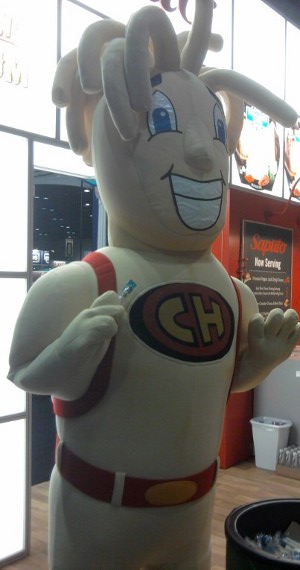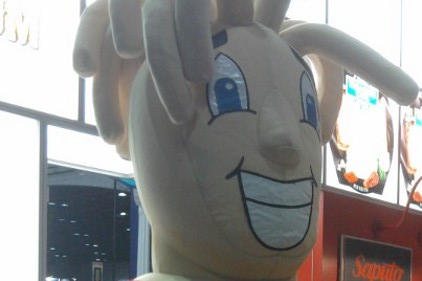
|
| He's not from Switzerland (CH). He's Saputo's Cheese Head |
I have identified a new condition unique to visitors attending trade shows that serve food. The condition is called TPS, or toothpick puncture syndrome. It results in broken skin on any of the fingers of the sufferer.
Here's how it happens: an interested party (a blogger, for example) approaches a booth serving cheese. The interested party (IP, for short) spears a sample with a toothpick. Not finding a nearby waste basket to discard the trash (and not one to litter), the IP puts the used toothpick in his pocket. Later, whilst retrieving a vibrating cell phone, the IP impales a fleshy part of his hand.
That IP was me in Orlando, Fla., on Sunday and Monday where I sampled cheeses at the annual expo of the International Dairy-Deli-Bake Association. From noon to five I ate all manner of cheeses and other dairy products. Most portions were as large as a thumbnail, but I ate enough cheese, bread and crackers over five hours that I didn't need lunch. Read my summary of trends here: "Spicy cheeses, ethnic flavors and snacking sizes dominate the dairy aisles at IDDBA."
What I didn't report there is that cheesemakers have interesting stories to tell about their products. The idea is to get their customers excited about the stories so that they will then re-tell the stories to consumers. Why buy Swiss cheese when you could buy Swiss cheese made in small batches from milk given by cows that spend their summers at high altitudes in the Bavarian Alps of Germany?
That's how Arla positions its Castello Alps Selection cheeses which it introduced in September 2012. Mette Hofman, Arla's vp of marketing, charmed me with the story of German dairy farmers (average herd size of 15) leading their cows up the mountain to graze on grasses and herbs in Alpine meadows.
Closer to home is the story of grass-fed baby Swiss cheese from Swiss Valley Farms of Iowa. That product is made from milk given by cows that eat grass year-round. In Idaho, Litehouse Inc. uses the adjectives "small batch," "vintage recipe," "hand-crafted" and "single-source milk" to describe its Center Cut Blue Cheese. It's not just blue cheese; it's a "premium" selection cut from the center of a wheel.
Try this experiment: At your next dinner party, divide a wheel of blue cheese into two sections. Tell your guests that some cubes are from an ordinary wheel of blue cheese and others were hand-crafted in small batches by artisans using single-source milk. Which do they prefer? And don' forget to give them a place to dispose of the toothpicks.


Recent Comments
Discount code
Alex Shimray
Thank you for sharing this! This is really...
Thank you for sharing this! This is really...
yes, nowadays more teenagers like to have a...